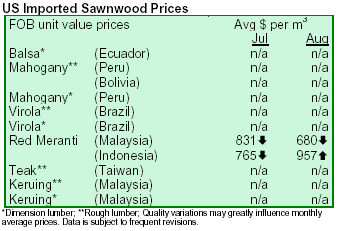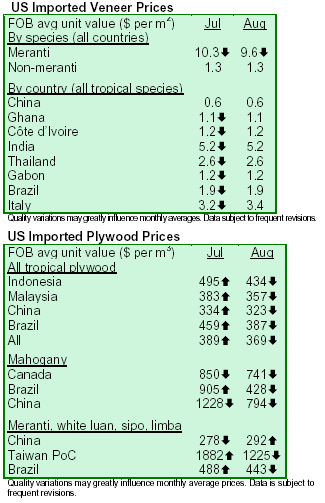|
Paraguay plywood may lose GSP duty-free treatment
Plywood imported from Paraguay (HTS 4412.13.25) has exceeded 50% of the value of total US imports of that
product in the year through August, according to IWPA. This would probably result in the termination of the
product¡¯s GSP duty-free treatment not later than 1 July 2007 since it would have exceeded the Competitive Need
Limitations (CNL) in the prior year. The US President may grant the product a CNL waiver if the value of total
imports of the product from all countries in 2006 does not exceed the applicable de minimis amount of $18 million.
USDA warns on impact of China¡¯s tariff changes
The US Foreign Agricultural Service (USDA) has warned that China¡¯s elimination of re-export preferences on solid
wood products could disrupt some US exports used in products for re-export from China and US companies that
have invested in Chinese manufacturing, IWPA reported. China cut the re-export preferences for a large category of
solid wood products, including veneer and lumber in September this year (see TTM 11:18). As a result, Chinese
wood manufacturers will now have to pay VAT and duty on some products that are imported, processed and then reexported
as value-added products, but that were previously without any import or export fees. USDA warned that
these changes would impact US and other companies thathad invested in Chinese manufacturing facilities that were
dependant on the ¡°processing trade¡± preferences.
CWP focuses promotional efforts on China
The Canadian Forest Service, a branch of the Federal Department of Natural Resources, is implementing the
¡°Canada Wood Programme¡± (CWP) designed to open up new opportunities in emerging foreign markets. The fiveyear
programme has been implemented since 2002 with
China as the prime target country.
Canadian suppliers of lumber and structural wood products are focusing efforts toward the building industry
in China. A growing desire among Chinese consumers for western-style accommodation, due partly to a rise in
disposable income among middle-class wage earners, may augers well for Canadian wood producers. However,
Canadian-style housing construction techniques are not well positioned in China. Most houses in China are built of
concrete and steel and there is a fear of wood being easily ignited. CWP endeavours to change this perception by
showing that wooden homes can be built using safe applications within a proper environment. This has led to
some encouraging results. In the latest revision of the Chinese building code, wood is now formally recognized
as a building material in residential housing thereby opening tremendous opportunities for Canadian wood
manufacturers in the future.
=
CWP also supports general promotional activities to introduce Canadian wood species and their attributes to
builders, consumers and government officials. This has been accomplished through seminars and participation at
trade shows, the distribution of brochures and other literature. Furthermore, CWP also participates in
demonstration projects, providing an opportunity to
showcase a number of wood species and their use in various finished applications, for example roofing systems
and multi-family housing.
Korea is another emerging market eyed by Canada. It is easier to penetrate this country due to its tradition in
wood-based building. CWP also aims at maintaining or revitalizing existing markets such as Japan and Europe.
The European market was largely lost in the 1990s due to
the implementation of non-tariff trade barriers and the emergence of new competitors.


¡¡
|